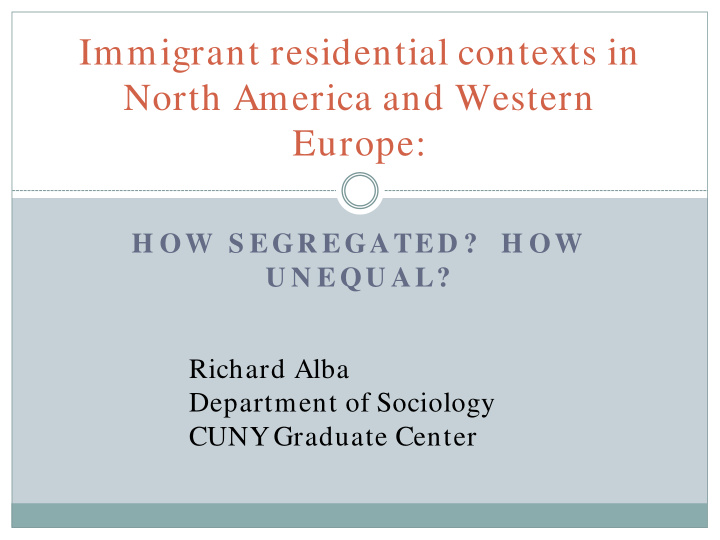



Immigrant residential contexts in North America and Western Europe: H OW S EGR EGATED ? H OW U N EQU AL? Richard Alba Department of Sociology CUNY Graduate Center
Acknowledgements Much of what I report comes from collaborative work with my colleague, Nancy Foner. See: Richard Alba and Nancy Foner, Strangers No More: Im m igration and the Challenges of Integration in North Am erica and Western Europe . Princeton: Princeton University Press, 2015. Richard Alba and Nancy Foner, “Immigration and the Geography of Polarization,” City & Com m unity (online, August, 2017).
Critical issues Are immigrant residential areas becoming parallel societies or, even more ominously, ghettoes? Recognizing that immigrants tend initially to go to areas of co-ethnic concentration, do they over time have the opportunity to improve their residential situation? Alternatively put, are immigrant neighborhoods intensifiers of disadvantage or way stations to integration?
Initial observation: Regional concentration Everywhere, immigrants tend to be concentrated regionally, though the degree of regional concentration varies from country to country. Many regions of concentration are centered on large cities. France is an extreme case, with 40 percent of the foreign born in and around Paris, and 20 percent in and around Lyons and Marseille. Canada and the Netherlands exhibit similar concentrations in just a few regions. In the U.S., regional concentration has weakened, with the emergence of “new destinations.” In Germany, it is relatively weak also because of the “directed” nature of much immigration, starting with the guestworkers. But there is a strong east/ west split.
Data about segregation Small-area composition, but the size of the areas used in different studies varies, from the buurt (avg size=2000) in the Netherlands, to the census tract in the U.S. (avg=4000) to the quartier of Paris (around 25,000). Principal indexes of segregation: Dissimilarity index, measure of evenness Exposure and isolation indexes, measures of contact probabilities
Index of Dissimilarity Values
Index of Isolation Values
Data about inequality: Much scarcer Hispanic families
Counter-trend: Rise of “global” neighborhoods (Logan and Zhang, 2010)
Other observations In both the U.S. and Western Europe, the areas with high immigrant concentration tend to be politically more favorable to diversity; the areas with low immigrant diversity tend to be less so. Evidence of the contact hypothesis? The relatively low segregation in the Netherlands hints at the impact of some public policies—in particular, the role of social housing.
Recommend
More recommend